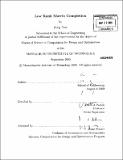Low rank matrix completion
Author(s)
Nan, Feng, S.M. Massachusetts Institute of Technology
DownloadFull printable version (3.276Mb)
Other Contributors
Massachusetts Institute of Technology. Computation for Design and Optimization Program.
Advisor
Pablo.A.Parrilo.
Terms of use
Metadata
Show full item recordAbstract
We consider the problem of recovering a low rank matrix given a sampling of its entries. Such problems are of considerable interest in a diverse set of fields including control, system identification, statistics and signal processing. Although the general low rank matrix completion problem is NP-hard, there exist several heuristic methods that solve the problem approximately by solving the convex relaxation of the original problem. One particularly popular method is to use nuclear norm (sum of singular values) to approximate the rank of the matrix and formulate the problem as a semidefinite program that can be solved efficiently. In this thesis, we propose a local completion algorithm that searches for possible completion in the neighborhood of each unspecified entry given the rank of the matrix. Unlike existing methods, this algorithm requires only local information of the matrix if the rank is known. Critical in all low rank matrix completion algorithms is the sampling density. The denser the matrix is sampled, the more likely it can be recovered accurately. We then propose a condensation process that increases the sampling density in a specific part of the matrix through elementary row and column re-ordering. Hence we can solve a sub-problem of the original low rank matrix completion problem and gain information on the rank of the matrix. Then the local algorithm is readily applicable to recover the entire matrix. We also explore the effect of additional sampling structures on the completion rate of the low rank matrix completion problems. In particular, we show that imposing regularity in the sampling process leads to slightly better completion rates. (cont.) We also provide a new semidefinite formulation for a particular block sampling structure that reduces the size of the constraint matrix sizes by a factor of 1.5.
Description
Thesis (S.M.)--Massachusetts Institute of Technology, Computation for Design and Optimization Program, 2009. Cataloged from PDF version of thesis. Includes bibliographical references (p. 75-76).
Date issued
2009Department
Massachusetts Institute of Technology. Computation for Design and Optimization ProgramPublisher
Massachusetts Institute of Technology
Keywords
Computation for Design and Optimization Program.